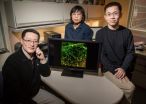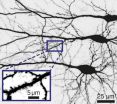(Press-News.org) CHAMPAIGN, Ill. — Researchers report they can generate human motor neurons from stem cells much more quickly and efficiently than previous methods allowed. The finding, described in Nature Communications, will aid efforts to model human motor neuron development, and to understand and treat spinal cord injuries and motor neuron diseases such as amyotrophic lateral sclerosis (ALS).
The new method involves adding critical signaling molecules to precursor cells a few days earlier than previous methods specified. This increases the proportion of healthy motor neurons derived from stem cells (from 30 to 70 percent) and cuts in half the time required to do so.
"We would argue that whatever happens in the human body is going to be quite efficient, quite rapid," said University of Illinois cell and developmental biology professor Fei Wang, who led the study with visiting scholar Qiuhao Qu and materials science and engineering professor Jianjun Cheng. "Previous approaches took 40 to 50 days, and then the efficiency was very low – 20 to 30 percent. So it's unlikely that those methods recreate human motor neuron development."
Qu's method produced a much larger population of mature, functional motor neurons in 20 days.
The new approach will allow scientists to induce mature human motor neuron development in cell culture, and to identify the factors that are vital to that process, Wang said.
Stem cells are unique in that they can adopt the shape and function of a variety of cell types. Generating neurons from stem cells (either embryonic stem cells or those "induced" to revert back to an embryo-like state) requires adding signaling molecules to the cells at critical moments in their development.
Wang and other colleagues previously discovered a molecule (called compound C) that converts stem cells into "neural progenitor cells," an early stage in the cells' development into neurons. But further coaxing these cells to become motor neurons presented unusual challenges.
Previous studies added two important signaling molecules at Day 6 (six days after exposure to compound C), but with limited success in generating motor neurons. In the new study, Qu discovered that adding the signaling molecules at Day 3 worked much better: The neural progenitor cells quickly and efficiently differentiated into motor neurons.
This indicates that Day 3 represents a previously unrecognized neural progenitor cell stage, Wang said.
The new approach has immediate applications in the lab. Watching how stem cells (derived from ALS patients' own skin cells, for example) develop into motor neurons will offer new insights into disease processes, and any method that improves the speed and efficiency of generating the motor neurons will aid scientists. The cells can also be used to screen for drugs to treat motor neuron diseases, and may one day be used therapeutically to restore lost function.
"To have a rapid, efficient way to generate motor neurons will undoubtedly be crucial to studying – and potentially also treating – spinal cord injuries and diseases like ALS," Wang said.
INFORMATION:
Editor's note: To reach Fei Wang, call 217-333-5972; email feiwang@illinois.edu.
The paper, "High-Efficiency Motor Neuron Differentiation From HumanPluripotent Stem Cells and the Function of Islet-1," is available online or to members of the media from the U. of I. News Bureau.
Team finds a better way to grow motor neurons from stem cells
2014-04-01
ELSE PRESS RELEASES FROM THIS DATE:
Science: Switching brain cells with less light
2014-04-01
This news release is available in German. Networked nerve cells are the control center of organisms. In a nematode, 300 nerve cells are sufficient to initiate complex behavior. To understand the properties of the networks, re-searchers switch cells on and off with light and observe the resulting behavior of the organism. In the Science journal, sci-entists now present a protein that facilitates the control of nerve cells by light. It might be used as a basis of studies of diseases of the nervous system. DOI: 10.1126/science.1249375
To switch a nerve cell with light, ...
Gratitude, not 'gimme,' makes for more satisfaction, Baylor University study finds
2014-04-01
People who are materialistic are more likely to be depressed and unsatisfied, in part because they find it harder to be grateful for what they have, according to a study by Baylor researchers.
The study — "Why are materialists less happy? The role of gratitude and need satisfaction in the relationship between materialism and life satisfaction" — appears in the journal Personality and Individual Differences.
"Gratitude is a positive mood. It's about other people," said study lead author Jo-Ann Tsang, Ph.D., associate professor of psychology and neuroscience in Baylor's ...
Clinical trial results inconsistently reported among journals, government website
2014-04-01
PORTLAND, Ore. — Medical researchers often presented the findings of their clinical trials in a different way on a federal government website than they did in the medical journals where their studies were ultimately published, according to an Oregon Health & Science University analysis published April 1 in the Annals of Internal Medicine.
Researchers' reports in peer-reviewed medical journals often were more favorable to the drug or intervention being studied than the reports on the government website — ClinicalTrials.gov — which required data for specific categories, ...
Sobering update on Jamaica's largest vertebrate
2014-04-01
In 1990, the Jamaican iguana was removed from the list of extinct species when a small population was re-discovered on the island. Unfortunately, the species continues to be critically endangered, with only a single location left for the recovering population, now greater than 200 individuals, in a protected area called the Hellshire Hills, part of the Portland Bight Protected Area. A recent proposal by Jamaican government officials to allow extensive development in this area is causing concern among conservationists who have been working to save this species and the wealth ...
Baylor professsor's study reveals strength training can decrease heart risks in children
2014-04-01
WACO, Texas (March 31, 2014) – Early strengthening activities can lead to a decrease in cardiometabolic health risks in children and adolescents, according to results of a new study by a Baylor University professor and a team of researchers.
Until recently, treatment for adolescent obesity and associated health problems has focused mostly on diet modifications and aerobic exercise such as walking or swimming.
But a recent research study appearing this month in Pediatrics by Paul M. Gordon, Ph.D., professor and chair of health, human performance and recreation department ...
Male-dominated societies are not more violent, study says
2014-04-01
Conventional wisdom and scientific arguments have claimed that societies with more men than women, such as China, will become more violent, but a University of California, Davis, study has found that a male-biased sex ratio does not lead to more crime.
Rates of rape, sexual assault and homicide are actually lower in societies with more men than women, the study found. And, evolutionary theories predicting that when males outnumber females, males will compete vigorously for the limited number of mates don't bear out. The study, "Too many men: the violence problem?" is ...
Scientific evidence shows need to regulate antimicrobial ingredients in consumer products
2014-04-01
Does the widespread and still proliferating use of antimicrobial household products cause more harm than good to consumers and the environment? Evidence compiled in a new feature article published in the journal Environmental Science & Technology by Arizona State University professor Rolf Halden shows that decades of widespread use of antimicrobials has left consumers with no measurable benefits.
Worse yet, lax regulation has caused widespread contamination of the environment, wildlife and human populations with compounds that appear more toxic than safe, according to ...
Research finding could lead to new therapies for patients with gluten intolerance
2014-04-01
Hamilton, ON (April 1, 2014) Researchers at McMaster University have discovered a key molecule that could lead to new therapies for people with celiac disease, an often painful and currently untreatable autoimmune disorder.
Celiac disease is a food sensitivity to dietary gluten contained in cereals. In people who are genetically predisposed, gluten containing food will trigger an immune response that leads to destruction of the intestinal lining, abdominal pain, changes in bowel habits, malnutrition and many other symptoms that include anemia, and neurological problems. ...
New screening tool to diagnose common sleep problem in children
2014-04-01
OTTAWA, Canada, April 1, 2014 — Clinical investigators at the Children's Hospital of Eastern Ontario (CHEO) have developed a new screening tool to help diagnose obstructive sleep apnea in children. Their findings are published in Pediatric Pulmonology.
Evidence suggests that adults with a large neck circumference are more likely to develop obstructive sleep apnea (OSA), especially males. As neck circumference varies by age and sex, there have been no reference ranges to diagnose pediatric OSA up until now. The new evidence-based diagnostic tool includes reference ranges ...
New test makes Parkinson's-like disorder of middle age detectable in young adulthood
2014-04-01
The very earliest signs of a debilitating neurodegenerative disorder, in which physical symptoms are not apparent until the fifth decade of life, are detectable in individuals as young as 30 years old using a new, sophisticated type of neuroimaging, researchers at UC Davis, the University of Illinois and UCLA have found.
People with the condition — fragile X-associated tremor/ataxia syndrome (FXTAS) — experience tremors, poor balance, cognitive impairments and Parkinsonism. The genetic condition results from a mutation in the fragile X mental retardation gene (FMR1). ...



